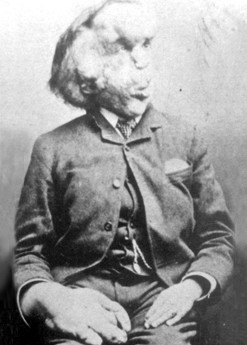- Proteus syndrome
Infobox_Disease
Name = Proteus syndrome

Caption =Joseph Merrick , a suspected sufferer of a severe case.
DiseasesDB = 30070
ICD10 =
ICD9 =
ICDO =
OMIM = 176920
MedlinePlus =
eMedicineSubj = derm
eMedicineTopic = 721
eMedicine_mult = eMedicine2|ped|1912
MeshID = D016715Proteus syndrome is a
congenital disorder that causesskin overgrowth and atypicalbone development, often accompanied bytumor s over half the body. Proteus syndrome is named after the Greek sea-godProteus , who could change his shape.Since Dr.
Michael Cohen identified it in1979 , [cite journal |author=Cohen MM, Hayden PW |title=A newly recognized hamartomatous syndrome |journal=Birth Defects Orig. Artic. Ser. |volume=15 |issue=5B |pages=291–6 |year=1979 |pmid=118782 |doi=] only a few more than 200 cases have been confirmed worldwide, with estimates that about 120 people are currently alive with the condition. [ [http://news.bbc.co.uk/2/hi/uk_news/england/lancashire/6621331.stm Woman's 11-stone legs may be lost] atBBC ] As attenuated forms of the disease may exist, there could be many people with Proteus Syndrome who remain undiagnosed. Those with obvious manifestations who are most readily diagnosed are also, unfortunately, the most severely disfigured.Notable cases
This extremely rare condition would have remained obscure, were it not for the fact that
Joseph Merrick — immortalized as the "Elephant Man" for a look imparted by his large facial tumours and the grayish hue of his overgrown skin — was lately diagnosed as having a particularly severe case of Proteus syndrome rather than, or in addition to, theneurofibromatosis that doctors once thought he had. [cite journal | author=Tibbles J, Cohen M | title=The Proteus syndrome: the Elephant Man diagnosed | journal=Br Med J (Clin Res Ed) | volume=293 | issue=6548 | pages=683–5 | year=1986 | pmid=3092979] Oddly, Merrick's left arm and his genitals were entirely unaffected by the condition that grotesquely deformed every other portion of his body.Presentation
Proteus syndrome causes an overgrowth of skin, bones, muscles, fatty tissues, and blood and lymphatic vessels.
Proteus syndrome is a progressive condition, wherein children are usually born without any obvious deformities. As they age, tumours as well as skin and bone growths appear. The severity and locations of these various
asymmetrical growths vary greatly but typically the skull, one or more limbs and soles of the feet will be affected. There is a risk of premature death in affected individuals due todeep vein thrombosis andpulmonary embolism caused by the vessel malformations that are associated with this disorder. Further risks may occur due to the mass of extra tissue - Merrick himself died when the weight of his head dislocated his neck while asleep.The disorder itself does not directly cause learning impairments: the distribution of intelligence among sufferers of Proteus syndrome mirrors that of the general population. However, the growths may cause secondary damage to the nervous system leading to cognitive disability. In addition, the presence of visible deformity may have a negative effect on the social experiences of the sufferer, causing cognitive and social deficits.
Afflicted individuals are at increased risk for developing certain tumors including unilateral ovarian cystadenomas, testicular tumors, meningiomas and monomorphic adenomas of the parotid gland.
Causes
Researchers are still trying to determine the cause(s) of Proteus syndrome. Some research has shown the condition linked to PTEN on
chromosome 10 , [cite journal |author=Smith JM, Kirk EP, Theodosopoulos G, "et al" |title=Germline mutation of the tumour suppressor PTEN in Proteus syndrome |journal=J. Med. Genet. |volume=39 |issue=12 |pages=937–40 |year=2002 |pmid=12471211|doi=10.1136/jmg.39.12.937] while other research points tochromosome 16 . [cite journal |author=Cardoso MT, de Carvalho TB, Casulari LA, Ferrari I |title=Proteus syndrome and somatic mosaicism of the chromosome 16 |journal=Panminerva medica |volume=45 |issue=4 |pages=267–71 |year=2003 |pmid=15206168 |doi= |url=http://cat.inist.fr/?aModele=afficheN&cpsidt=15505734]Treatment
While no actual cure exists, a team of doctors in Australia have trial tested the drug Rapamycin in the treatment of Proteus Syndrome, and have found it to be an effective remedy. [http://www.abc.net.au/catalyst/stories/2332949.htm]
Classification
Many sources classify Proteus syndrome to be a type of
nervous syndrome. Due to the mosaic distribution of lesions, it is hypothesized (but not confirmed) that the disorder is an example of geneticmosaicism .Cite journalissn = 01487299
volume = 47
issue = 5
pages = 645–52
last = Cohen
first = M M
title = Proteus syndrome: clinical evidence for somatic mosaicism and selective review
journal = American journal of medical genetics
date = 1993-10-01
pmid = 8266991doi = 10.1002/ajmg.1320470514
]
=References=
*
*External links
* [http://www.proteus-uk.org The Proteus Family Network UK]
* [http://www.proteus-syndrome.org The Proteus Syndrome Foundation]
Wikimedia Foundation. 2010.
